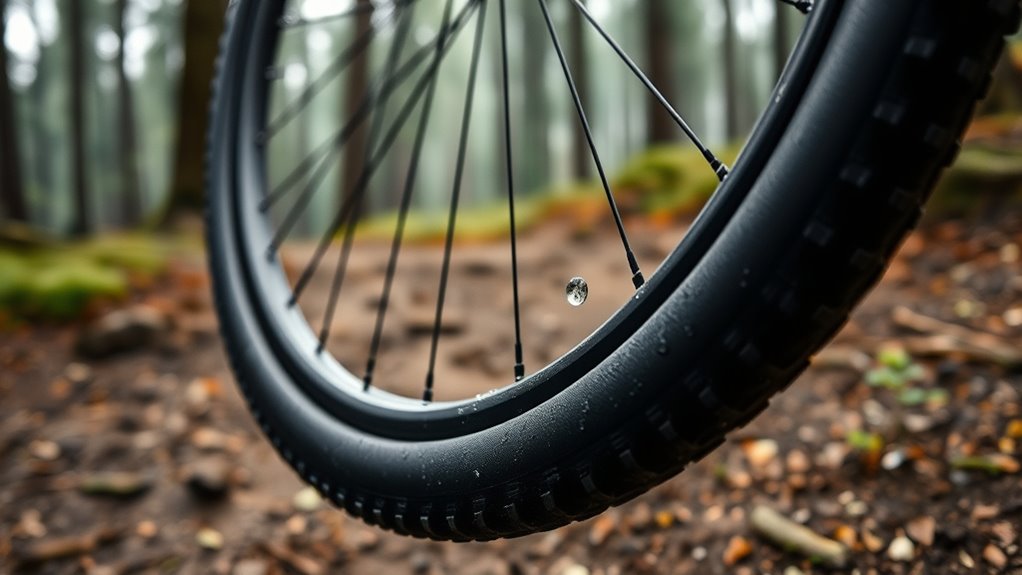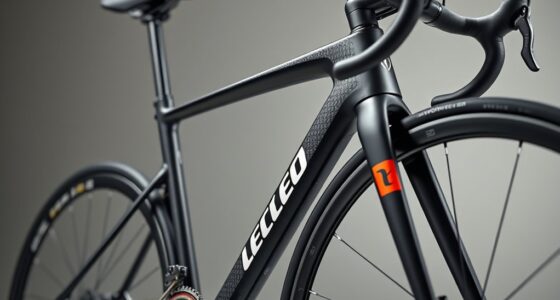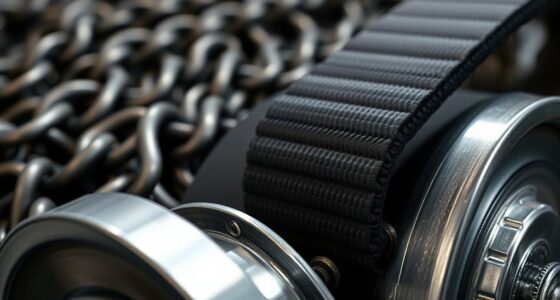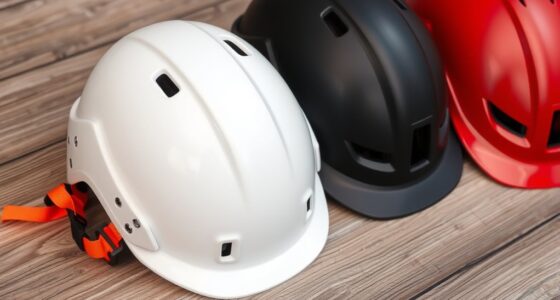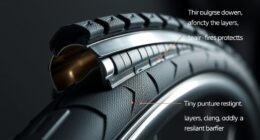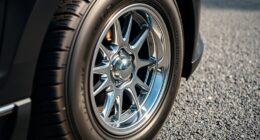Tubeless technology offers you several benefits, such as fewer flats thanks to self-sealing sealants, a smoother ride, and improved efficiency with lower rolling resistance. It also reduces weight by eliminating inner tubes and enhances grip on various terrains. However, tubeless systems require proper setup, compatible tires, and regular maintenance like sealant top-ups. While it boosts performance, understanding its limits can help you get the most out of this innovative setup—stay tuned to learn more.
Key Takeaways
- Tubeless tech reduces flats through self-sealing sealant, enhancing reliability during rides.
- It offers lower rolling resistance and smoother ride quality, improving efficiency and comfort.
- Proper tire compatibility and bead seating are essential to prevent leaks and ensure safety.
- Limitations include sealant drying out and potential difficulties in installation or repairs.
- Regular maintenance, including sealant top-ups and pressure checks, maximizes tubeless performance.
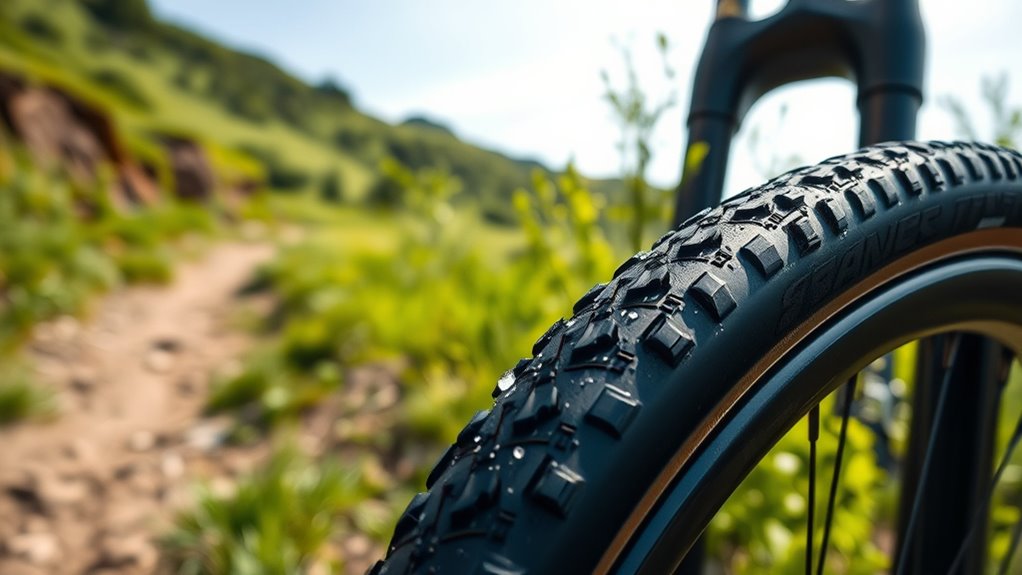
Have you ever wondered how tubeless technology has revolutionized the way we ride? It’s no secret that tubeless setups have become increasingly popular among cyclists, mountain bikers, and even road riders. The appeal lies in fewer flats, lower rolling resistance, and a smoother ride overall. But to keep these benefits, you need to understand tubeless maintenance and tire compatibility. Proper maintenance ensures your setup remains reliable, while choosing the right tires is essential for performance and safety.
When it comes to tubeless maintenance, it’s about staying on top of a few key tasks. First, you’ll want to regularly check for leaks or punctures. Unlike traditional tires that require inner tubes, tubeless tires rely on sealant to close small holes. Over time, the sealant can dry out or become less effective, so you should top it up every few months. This simple step can prevent unexpected flats and keep your ride smooth. Also, inspect the rim tape and valve core periodically to verify there’s no damage or debris that could compromise the seal. Maintaining proper tire pressure is equally important. Running the correct pressure not only improves traction but also minimizes the risk of pinch flats or bead leaks. Use a good floor pump with a gauge to get accurate readings. And finally, when installing new tires or replacing sealant, make sure the bead seats properly on the rim; a poorly seated bead can cause leaks or even blowouts during rides. Additionally, understanding how Glycolic Acid Exfoliating Toner can benefit your skin can make your skincare routine more effective and enjoyable.
Tire compatibility plays an essential role in the performance and safety of your tubeless system. Not all tires are designed for tubeless use, so you need to select tires compatible with your rim and sealant. Check the sidewall for markings like “tubeless ready” or “UST” to confirm compatibility. Using incompatible tires might result in poor sealing, frequent leaks, or difficulty in mounting the tires onto the rim. Wide rims demand tires with specific bead profiles to guarantee a secure fit, which affects ride quality and puncture resistance. It’s also important to match tire width to your riding style and terrain. Narrower tires are lighter and faster on smooth surfaces, while wider tires provide more grip and comfort off-road. Before mounting, always verify that the tire’s bead will seat properly on the rim, especially if you’re mixing different brands or models. Proper tire compatibility not only makes installation easier but also ensures that your tubeless system performs at its best, giving you peace of mind on every ride.
Frequently Asked Questions
Can Tubeless Tires Be Used on All Types of Bikes?
Yes, you can use tubeless tires on most bike types, but it’s crucial to check bike frame compatibility first. Some frames may not support tubeless setups due to valve hole sizes or rim design. You’ll also need to learn proper valve installation techniques to guarantee a secure seal. If your bike’s compatible and you follow the right steps, tubeless tires can improve your ride’s performance and reduce flats.
What Are the Long-Term Maintenance Requirements for Tubeless Systems?
You need to regularly check your tubeless system’s sealant longevity, replacing it every few months to prevent leaks. Keep your valve maintenance up by inspecting and cleaning valves to guarantee proper sealing. Also, monitor tire pressure frequently, as tubeless setups often lose air over time. Proper maintenance helps avoid flats, extends tire life, and keeps your ride smooth. With consistent care, your tubeless system stays reliable and efficient.
How Do Tubeless Tires Perform in Extreme Cold or Hot Weather?
In extreme cold or hot weather, tubeless tires can perform well if you pay attention to temperature resilience and sealant effectiveness. Cold climates might cause sealant to thicken or lose adhesion, while heat can accelerate evaporation or cause punctures. You maintain performance steady by choosing the right sealant, monitoring its condition, and adjusting pressures accordingly. Proper maintenance ensures your tubeless tires stay reliable, no matter the weather conditions.
Are Tubeless Setups Compatible With All Rim Types?
You might find that tubeless setups aren’t compatible with all rim types. Check your rim’s compatibility, especially if it’s designed for tubeless tires, to guarantee a proper fit. Also, consider valve types—some rims require specific valves for sealing and inflation. Always verify your rim’s specifications and valve compatibility before switching to a tubeless system to avoid leaks or installation issues.
What Safety Measures Should Be Taken During Tubeless Installation?
Think of tubeless installation as creating a tight seal on a ship’s hull. You should carefully install the valve, ensuring it’s snug and secure to prevent leaks. When applying sealant, do it in a well-ventilated area, and wear gloves to avoid skin contact. Double-check the valve and sealant coverage, then inflate slowly, watching for any leaks. These steps keep your setup safe and reliable on every ride.
Conclusion
Just as Da Vinci’s innovations transformed art and science, tubeless technology revolutionizes your ride by reducing flats and enhancing performance. But remember, even the most advanced tools have limits—like the delicate balance of a tightrope walker. Embrace tubeless tires for their benefits, yet stay aware of their boundaries. With knowledge and care, you’ll navigate your journey smoothly, turning every ride into a masterpiece on two wheels.
